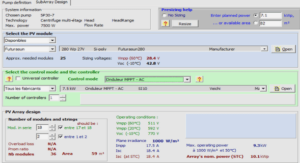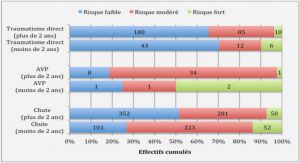Numerical schemes for Hydrodynamics
Discrete properties To deal with all the features introduced in section 1.1, numerical hydrodynamic schemes have to meet the following requirements : (i) local mass conservation (ensured by the Lagrangian assumption) ; (ii) momentum conservation (only for the axial component in axisymmetric geometry) ; (iii) total energy conservation which is critical for capturing strong shocks [6] ; and (iv) entropy increase for non-smooth flows. Point (iv) is the compliance with the Second Principle of Thermodynamics (1.6) which plays an important role for robustness, especially for complex EOSs. The capture of isentropic flows—meaning the conservation of entropy—complements the second principle. Both of these properties are termed thermodynamic consistency in this PhD dissertation. Note that the thermodynamic consistency terminology may also include the total energy conservation (First Principle 1.4. Numerical schemes for Hydrodynamics 5 the Thermodynamics) [7]. Robustness in Lagrangian descriptions is primarily limited by mesh distortions that appear in strongly sheared and vortical flows. Furthermore, even for smooth flows, distortions can still appear as so-called “non-physical” or “hourglass” modes. As a consequence of these mesh distortions, fundamental symmetries are breaking on some flows of great interest. In particular, for inertial confinement fusion (ICF) simulations in axisymmetric geometry, Rayleigh-Taylor instabilities may be amplified by the loss of the spherical symmetry [8–10], degrading even more the mesh and leading to unacceptably large errors in the numerical solution. The reader can refer to [11] for an example of such singularity. An other exampleof symmetry breaking in axisymmetric geometry is considered and studied in this work. In that case, some numerical results are provided on a simple flow and a solution to preserve the planar symmetry is proposed : see chapters 3 and 5. It is well-known that satisfying all these properties simultaneously is a difficult task. As an example, considering 2D meshes where nodes are connected by straight lines, Whalen shows in [12] that one cannot preserve energy, entropy and sphericity at the same time, even on equal-angle polar meshes aligned with the flow. Therefore, one has to emphasise some properties, which depend on the problem, at the expense of others. As an example, in this work, the emphasis is put on thermodynamic consistency—crucial for CEA’s applications—and the constraint of the strict momentum conservation is relaxed.
ALE methodology Principle Prior to the introduction of Arbitrary-Lagrangian-Eulerian (ALE) methods [13, 14], the mesh motion was restricted to a Lagrangian evolution—where the mesh follows the fluid—or an Eulerian evolution—where the mesh is fixed throughout the calculation. Although Lagrangian methods present a lot of advantages, they are also prone to severe mesh tangling and cannot capture large deformations, vorticity or shear. At best, these large mesh distortions result in a loss of accuracy but, in general, they break the calculation down long before reaching the final time. On the other hand, Eulerian methods can handle such deformations since the mesh is fixed but they fail to maintain sharp interfaces and produce diffusive solutions. Noticing that Eulerian and Lagrangian are only two particular mesh motions, ALE techniques sucessfully combine the best of the two previous approaches by allowing the mesh to move with an arbitrary velocity. A full and recent review of ALE schemes is available in [3]. Direct vs indirect ALE In the context of ALE simulations, additionnal advective terms—inevitably appearing in the system (1.1a)-(1.1b)-(1.1c) since the mesh does not necessarly move with the fluid velocity—can be taken into account directly in the PDEs or can be solved in a seperate step [15]. The first case, usually termed “direct ALE” in the 6 Chapitre 1. literature [16–18], is computationally more efficient than the second one but introduces more complexity in discrete equations since all terms are treated at the same time. In particular, the least action principle—also used in this work—is taken in [17, 18] as a guideline when deriving the scheme in order to handle such complexity. This procedure allows the authors of [17, 18] to ensure an overall compatibility between all discrete terms. “Lagrange + Remap” methodology We only consider in this work “indirect ALE” or “Lagrange + Remap”, largely used at CEA. The ALE algorithm is commonly split into three steps : (i) a Lagrangian update of variables where the mesh moves with the fluid velocity ; (ii) a rezoning (or regularization) phase where the mesh quality is improved ; and (iii) a remapping phase consisting in a conservative transfer of the fields from the Lagrangian to the rezoned mesh. This separation introduces appreciable advantages : (i) it reduces the overall algorithm complexity ; (ii) existing and well-known Lagrangian solvers can be naturally extended to the ALE methodology by simply adding rezoning and remapping phases ; (iii) it allows to preserve good properties of these Lagrangian solvers in terms of thermodynamic consistency. The latter is usually achieved by a monotone remapping of the internal energy. In this case, the remapped internal energy is constrained to stay positive through non-linear mechanisms [19, 20]. Note that the repair paradigm [21–23]—see chapter 6 for more details—or flux corrected transport (FCT) [24–26] can also be used for that purpose. Rezoning phase Rezoning consists in improving the computational mesh quality—to prevent concave cells for instance—degraded by the flow or the “non-physical” modes : see figure 1.2. The reader can refer to [27–30] for rezoning algorithms. While it is not discussed in this dissertation, the analysis of chapter 6 can apply even with connectivity changes between Lagrangian and rezoned meshes. Such a rezoning can be found in [31]. Remapping phase The remapping phase is required in order to transfer the fields from the Lagrangian mesh to the rezoned mesh.
“Lagrange + Remap” schemes : state-of-the-art
A state-of-the-art on “Lagrange + Remap” methods is proposed here, based on [3, 40]. Throughout the present work “ALE” will designate “Lagrange + Remap” unless otherwise specified. This subsection does not intend to be comprehensive. This is actually difficult knowing the number of methods and algorithms—both reported and unreported—developed since the 1950s. The goal is to give an overview of major difficulties in constructing a numerical hydrodynamic method. Most of these difficulties are still present today and some of them are treated in this PhD dissertation. In particular, this state-of-the-art shows that the thermodynamic consistency is still largely unexplored in the literature, partially justifying the focus on this property. The subsection is organized following three discretizations largely used in hydrodynamic schemes : (i) Space- and Time-Staggered (STS) ; (ii) Space-Staggered and Time-Centered or Staggered-Grid Hydro (SGH) ; (iii) Space- and Time-Centered or Cell-Centered Hydro (CCH).
Conservation
In a Lagrangian context, although mass and momentum conservation are already fully satisfied in the VNR scheme, the situation for the total energy is more complex. Indeed, the time-staggering of the velocity—and the kinetic energy by extension— with respect to the internal energy implies a non-trivial definition of the total energy. This energy non-conservation issue was studied in 1D by Trulio & Trigger [51] in 1961 but the first satisfactory answer came from Burton in 1991 [52], at the price of a modified time stepping with respect to the original VNR scheme. He also highlighted the concept of corner masses and forces, largely re-used in the context of SGH (see subsection 1.4.3.2). More recently, Llor et al. [53] provide a generalization of Burton’s work, showing that Lagrangian STS schemes, including VNR like time steppings, can actually be made to conserve total energy. These conservation extensions are referred as Conservative STS (CSTS) in this PhD dissertation and represent the starting point of this work. From an ALE point of view, it seems that no effort were provided to develop a conservative remapping since that property was already not fullfilled in the Lagrangian step.
Space-Staggered and Time-Centered discretizations
The choice of centering all variables at the same time tackles the total energy definition issue and naturally simplifies its conservation. But almost all other questions, adressedfor STS discretizations in subsection 1.4.3.1, still remain for Space-Staggered and TimeCentered (SGH) schemes. In particular, the paper series [62–65] of Caramana et al. discussed several improvements including the total energy conservation, hourglass control or artificial viscosity. It is worth mentioning that Caramana et al. reuse the choice of Pracht [48]—adapted to 2D and only computed on the reference configuration—concerning the node mass definition. A more detailed discussion is carried in chapter 6 concerning the staggered remap issues presented here and the link with our work. High-order methods have been developed in the context of SGH using finite difference [66], finite volume [67], finite element [11, 68] (based on previous low-order algorithms [69–72]) or discontinuous Galerkin [73, 74] approaches. By increasing the overall accuracy, these high-order extensions naturally improve some important properties such as capture of isentropic flows or symmetry preservation—see [11] for an axisymmetric formulation of high-order SGH discretizations on curvilinear meshes. Of course, a better accuracy also implies an additional computational cost. Conservation Because of the internal energy formulation, special care has been taken to ensure energy conservation for Lagrangian SGH schemes : (i) the support operator method [75, and references therein]—using variational approaches—or mimetic discretizations [76] mimick vectorial relations on the gradient and the divergence at the discrete level ; and (ii) compatible discretizations [62, 77] constrain the pressure work to match between the kinetic and internal energies. The latter is used in [53] and the present work. For ALE methods, some issues arise in a space-staggered context when remapping fields. In particuliar, one has to deal with inconsistencies between centered and staggered fields in order to conserve compatible definitions of mass and momentum with the Lagrangian phase. This is achieved through global constraint optimization both for flux-based [78, 79] and for intersection-based [80] remap. The total energy conservation is ensured by the classical “DeBar kinetic energy fix” [50]. It consists in adding the kinetic energy error due to the remapping in the internal energy. Of course, this implies some precautions which are discussed in the next paragraph. Robustness and entropy An artificial viscosity term and hourglass mode control are still necessary in SGH schemes. The artificial viscosity is improved [64, 81, 82], keeping the tensorial form introduced by Schultz [58], while hourglass control is developed from the simplest correction [83] to more complex and general ones [63, 84, 85]. Note that Cell-Centered Grid Hydro (CCH) discretizations—see the next subsection—also motivated some study on the internal consistency in the context of SGH [86, 87], including the so-called Geometric Conservation Law (GCL). When using a monotone remapping, robustness and entropy questions are almost only related to the “DeBar kinetic energy fix”. Unfortunately, these questions are not well documented, with the notable exception of [3, 88] where the authors recognize [3, § 9.3] that : “In principle, the kinetic energy fix can produce negative internal energies”. The remapping only being a transfer of information from one mesh to another, entropy—as any other field—has to be preserved as much as possible. In this spirit, Bailey et al. [89] proposed to minimize the kinetic energy error (based on [90]) for flux-based remap. After the DeBar correction, it is also possible to constrain the internal energy to be positive thanks to the repair paradigm [21–23], provided that remapping is dissipative [23]. Symmetry The time centering of variables does not solve the symmetry preservation issue. In particular, Caramana and Whalen proposed in [65] an algorithm that preserves cylindrical (in plane 2D) and spherical (in axiymmetric geometry) symmetries, even on uneven angle polar grids. However, this is done by modifying the pressure force discretization, possibly leading to entropy violation through geometric errors on volume variations. To extend such improvements to the ALE methodology, a remap preserving the spherical symmetry on equi-angular polar grids is presented in [5] for axisymmetric geometry.
|
Table des matières
1 Introduction
1.1 Motivations
1.2 Lagrangian Hydrodynamics
1.3 Axisymmetric geometry
1.4 Numerical schemes for Hydrodynamics
1.4.1 Discrete properties
1.4.2 ALE methodology
1.4.3 “Lagrange + Remap” schemes : state-of-the-art
1.4.3.1 Space- and Time-Staggered discretizations
1.4.3.2 Space-Staggered and Time-Centered discretizations
1.4.3.3 Space- and Time-Centered discretizations
1.5 Present approach
1.5.1 Lagrangian phase
1.5.2 Remapping phase
1.5.3 Summary
1.5.4 Some ALE numerical results
1.6 Overview of this work
2 Schémas numériques lagrangiens CSTS
2.1 Introduction
2.2 Cadre multi-matériaux
2.3 Intégrale d’action discrète et application du principe de moindre action
2.4 Schéma CSTS à masses nodales constantes non diagonales
2.4.1 Intégrale d’action discrète
2.4.2 Équation discrète de quantité de mouvement et modèle de fermeture
2.4.3 Prédicteur/correcteur pour l’équation de quantité de mouvement
2.4.4 Équation discrète d’énergie cinétique
2.4.5 Équation discrète d’énergie interne
2.4.6 Construction de l’énergie interne décalée
2.4.7 Propriétés du schéma
2.4.7.1 Conservation de la masse
2.4.7.2 Consistance
2.4.7.3 Conservation de la quantité de mouvement
2.4.7.4 Conservation de l’énergie totale
2.4.7.5 Cohérence thermodynamique
2.5 Schéma CSTS à masses nodales variables
2.5.1 Intégrale d’action discrète
2.5.2 Équation discrète de quantité de mouvement et modèle de fermeture
2.5.3 Prédicteur/correcteur pour l’équation de quantité de mouvement
2.5.4 Équation discrète d’énergie cinétique
2.5.5 Équation discrète d’énergie interne
2.5.6 Construction de l’énergie interne décalée
2.5.7 Propriétés du schéma
2.5.7.1 Conservation de la masse
2.5.7.2 Consistance de la quantité de mouvement
2.5.7.3 Conservation de la quantité de mouvement
2.5.7.4 Conservation de l’énergie totale
2.5.7.5 Cohérence thermodynamique
2.6 Conclusion du chapitre
3 Géométrie
3.1 Généralités
3.2 Calcul des volumes axisymétriques Vc
3.2.1 Expressions explicites
3.3 Construction des masses de coin mcp
3.3.1 Définitions des volumes de contrôle Vcp
3.3.2 Expressions explicites
3.3.3 Propriétés
3.4 Construction des vecteurs de volume de coin ∂Vc ∂xp
3.4.1 Expressions explicites
3.4.2 Propriétés
3.5 Construction des vecteurs de masse de coin ∂mcq ∂xp
3.5.1 Expressions explicites
3.5.2 Propriétés
3.6 Vérification des hypothèses de consistance pour le schéma VNM
3.7 Dépendances radiales des quantités géométriques
3.7.1 Dépendances radiales et préservation des symétries
3.7.2 Analyse des termes de l’équation de quantité de mouvement
3.7.3 Analyse des termes de l’équation d’énergie interne
3.7.4 Résumé
3.8 Conclusion du chapitre
4 Construction et analyse des termes dissipatifs
4.1 Terme de pseudo-viscosité
4.1.1 Principe de la méthode et cahier des charges
4.1.2 Construction du terme de pseudo-viscosité et propriétés
4.2 Terme d’anti-dérive
4.2.2 Corrections d’anti-dérive en vitesse
4.2.2.2 Propriétés
4.2.3 Corrections d’anti-dérive en force
4.2.3.1 Principe
4.2.3.2 Propriétés
4.2.4 Corrections d’anti-dérive par filtrage inertiel
4.2.4.1 Principe
4.2.4.2 Propriétés
4.3 Conclusion du chapitre
5 Résultats numériques lagrangiens en géométrie axisymétrique
5.1 Généralités
5.2 Tube à choc de Sod
5.2.1 Présentation des cas test
5.2.1.1 Tube à choc de Sod plan
5.2.1.2 Tube à choc de Sod sphérique
5.2.2 Solution de référence
5.2.3 Résultats numériques
5.2.3.1 Tube à choc de Sod plan
5.2.3.2 Tube à choc de Sod sphérique
5.3 Compression isentropique de Kidder
5.3.1 Présentation du cas test
5.3.2 Solution de référence
5.3.3 Résultats numériques
5.4 Onde de choc de Noh
5.4.1 Présentation des cas test
5.4.1.1 Onde de choc de Noh plan
5.4.1.2 Onde de choc de Noh sphérique
5.4.2 Solution de référence
5.4.3 Résultats numériques
5.4.3.1 Onde de choc plane de Noh
5.4.3.2 Onde de choc de Noh sphérique sur maillages polaires
5.4.3.3 Onde de choc de Noh sphérique sur maillage cartésien
5.5 Onde de choc de Sedov
5.5.1 Présentation du cas test
5.5.2 Solution de référence
5.5.3 Résultats numériques
5.6 Conclusion du chapitre
6 Extension des schémas CSTS à la méthodologie ALE
6.1 Introduction au schéma ALE
6.2 Phase de régularisation et de projection à l’instant t n+1/2
6.2.1 Introduction
6.2.2 Attentes sur la phase de projection
6.2.3 Méthode de Dukowicz
6.2.4 Projection sur le maillage primal
6.2.4.1 Aspect multi-matériaux
6.2.4.2 Définition des quantités centrées projetées
6.2.5 Projection sur le maillage dual
6.2.6 Résultats intermédiaires sur la phase de projection
6.2.6.1 Conservation des quantités projetées
6.2.6.2 Conservation de la quantité de mouvement
6.2.6.3 Conservation de l’énergie totale
6.2.6.4 Cohérence thermodynamique
6.2.6.5 Préservation d’un champ de vitesse constant
6.2.6.6 Continuité de la projection
6.3 Transfert de masse et erreur d’énergie cinétique
6.3.1 Introduction
6.3.2 Transfert de masse
6.3.3 Corrections de vitesse
6.3.4 Corrections de l’énergie interne
6.4 Propriétés de l’algorithme ALE global
6.4.1 Conservation de la quantité de mouvement
6.4.2 Conservation de l’énergie totale
6.4.3 Respect de la cohérence thermodynamique
6.4.4 Continuité du schéma ALE
6.5 Conclusion du chapitre
7 Résultats numériques en formulation ALE
7.1 Généralités
7.2 Tube à choc de Sod en géométrie axisymétrique
7.2.1 Présentation du cas test
7.2.2 Solutions de référence
7.2.3 Résultats numériques
7.3 Vortex isentropique
7.3.1 Présentation du cas test
7.3.2 Solution de référence
7.3.3 Résultats numériques
7.4 Onde de choc sphérique de Sedov
7.4.1 Présentation du cas test
7.4.2 Solution de référence
7.4.3 Résultats numériques
7.5 Point triple en géométrie axisymétrique
7.5.1 Présentation du cas test
7.5.2 Solution de référence
7.5.3 Résultats numériques
7.6 Interaction choc-bulle
7.6.1 Présentation du cas test
7.6.1.1 Géométrie plane
7.6.1.2 Géométrie axisymétrique
7.6.2 Solution de référence
7.6.3 Résultats numériques
7.6.3.1 Géométrie plane
7.6.3.2 Géométrie axisymétrique
7.7 Conclusion du chapitre
8 Conclusion & Perspectives
A Démonstration des résultats du Chapitre 2
A.1 Démonstration de la consistance du schéma CCNM
A.2 Démonstration de la cohérence thermodynamique du schéma VNM
B Application des conditions aux limites
C Démonstration des résultats du Chapitre 3
C.1 Vérification des volumes axisymétriques Vc
C.2 Verification des vecteurs de volume de coin ∂Vc ∂xp
C.3 Vérification des vecteurs de masse de coin ∂mcq ∂xp
C.4 Vérification des hypothèses de consistance pour le schéma VNM
C.4.1 Approximation du volume de coin VMcp au premier ordre
C.4.2 Vérification des hypothèses de consistance
C.4.3 Calcul explicite des variations de masse sur maillage régulier
C.5 Expressions des forces pour un mouvement purement axial
C.6 Expressions des masses nodales pour un mouvement purement axial
C.7 Expression des flux de quantité de mouvement pour un mouvement purement axial
C.8 Expression de la divergence discrète de la vitesse pour un mouvement purement axial
C.9 Expression des termes masses variables de l’énergie interne pour un mouvement purement axial
D Démonstration des résultats du Chapitre 6
D.1 Analyse de l’erreur due au transfert de masse
D.1.1 Approximation du volume VMp au premier ordre
D.1.2 Écart entre les volumes VDp et VMp
D.1.3 Consistance de la densité nodale ρp
D.2 Cohérence thermodynamique de la correction en énergie interne
D.3 Continuité de la correction en énergie interne
D.4 Conservation de la quantité de mouvement du schéma ALE
D.5 Conservation de l’énergie totale du schéma ALE
Bibliographie
![]() Télécharger le rapport complet
Télécharger le rapport complet






